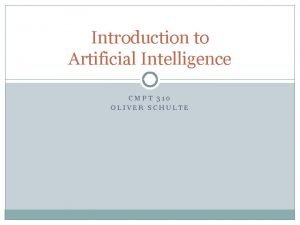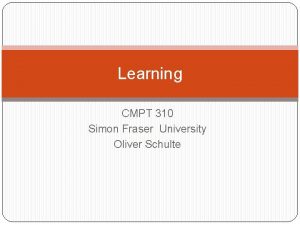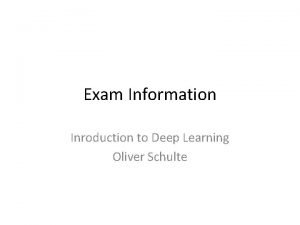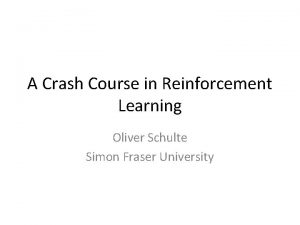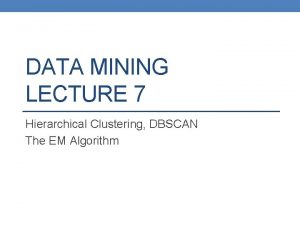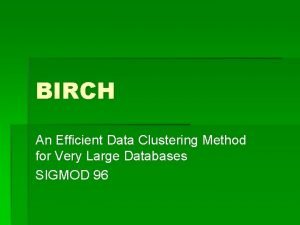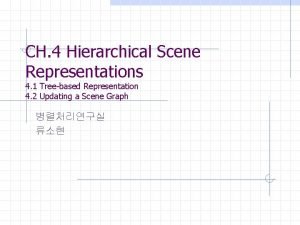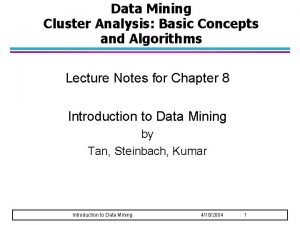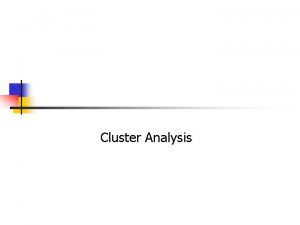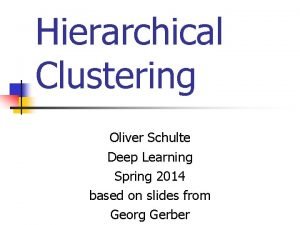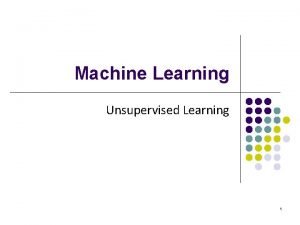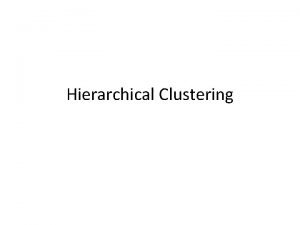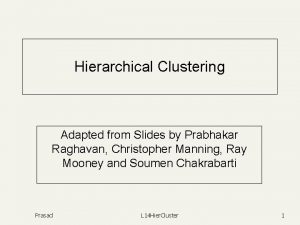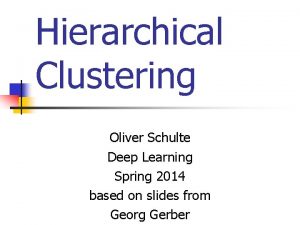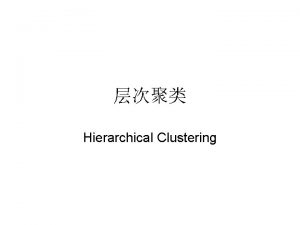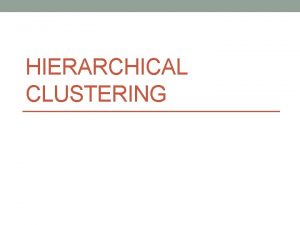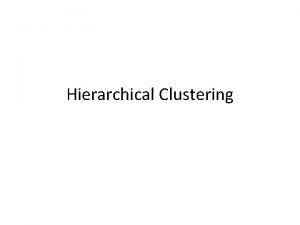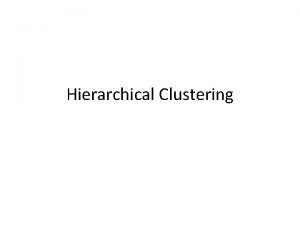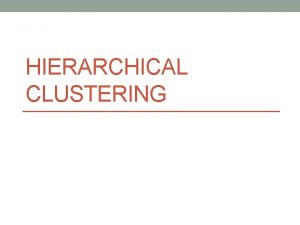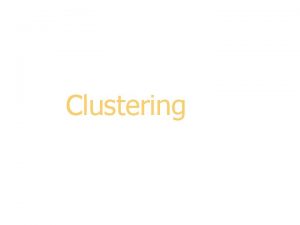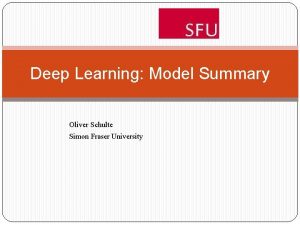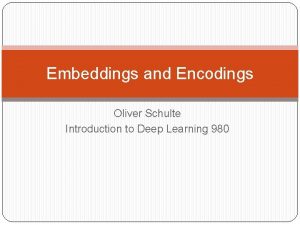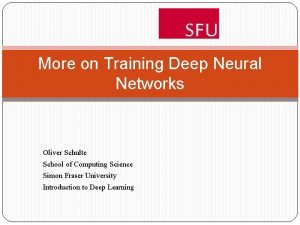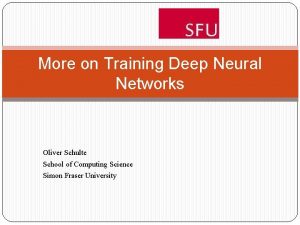Hierarchical Clustering Oliver Schulte Deep Learning Spring 2014















- Slides: 15

Hierarchical Clustering Oliver Schulte Deep Learning Spring 2014 based on slides from Georg Gerber

Hierarchical Agglomerative Clustering n n n We start with every data point in a separate cluster We keep merging the most similar pairs of data points/clusters until we have one big cluster left This is called a bottom-up or agglomerative method

Hierarchical Clustering (cont. ) n This produces a binary tree or dendrogram n n The final cluster is the root and each data item is a leaf The height of the bars indicate how close the items are

Hierarchical Clustering Demo

Linkage in Hierarchical Clustering n n n We already know about distance measures between data items, but what about between a data item and a cluster or between two clusters? We just treat a data point as a cluster with a single item, so our only problem is to define a linkage method between clusters As usual, there are lots of choices…

Centroid and Average Linkage n Centroid Linkage n n n Each cluster ci is associated with a mean vector i which is the mean of all the data items in the cluster The distance between two clusters ci and cj is then just d( i , j ) Average linkage n the average of all pairwise distances between points in the two clusters

Single Linkage n n The minimum of all pairwise distances between points in the two clusters Tends to produce long, “loose” clusters

Complete Linkage n n The maximum of all pairwise distances between points in the two clusters Tends to produce very tight clusters

Hierarchical Clustering Issues n n n Disjoint clusters are not produced – sometimes this can be good, if the data has a hierarchical structure w/o clear boundaries There are methods for producing distinct clusters, but these usually involve specifying somewhat arbitrary cutoff values What if data doesn’t have a hierarchical structure? Is HC appropriate?

Self-Organizing Maps n n Based on work of Kohonen on learning/memory in the human brain As with k-means, we specify the number of clusters However, we also specify a topology – a 2 D grid that gives the geometric relationships between the clusters (i. e. , which clusters should be near or distant from each other) The algorithm learns a mapping from the high dimensional space of the data points onto the points of the 2 D grid (there is one grid point for each cluster)

Self-Organizing Maps (cont. ) 10, 10 Grid points map to cluster means in high dimensional space (the space of the data points) 11, 11 Each grid point corresponds to a cluster (11 x 11 = 121 clusters in this example)

Self-Organizing Maps (cont. ) n Suppose we have a r x s grid with each grid point associated with a cluster mean 1, 1, … r, s n n n SOM algorithm moves the cluster means around in the high dimensional space, maintaining the topology specified by the 2 D grid (think of a rubber sheet) A data point is put into the cluster with the closest mean The effect is that nearby data points tend to map to nearby clusters (grid points)

Self-Organizing Map Example This is a 4 x 3 SOM and the centre of each cluster is displayed

SOM Issues n n The algorithm is complicated and there a lot of parameters (such as the “learning rate”) - these settings will affect the results The idea of a topology in high dimensional feature spaces is not exactly obvious n n n How do we know what topologies are appropriate? In practice people often choose nearly square grids for no particularly good reason As with k-means, we still have to worry about how many clusters to specify…

Parting thoughts: from Borges’ Other Inquisitions, discussing an encyclopedia entitled Celestial Emporium of Benevolent Knowledge “On these remote pages it is written that animals are divided into: a) those that belong to the Emperor; b) embalmed ones; c) those that are trained; d) suckling pigs; e) mermaids; f) fabulous ones; g) stray dogs; h) those that are included in this classification; i) those that tremble as if they were mad; j) innumerable ones; k) those drawn with a very fine camel brush; l) others; m) those that have just broken a flower vase; n) those that resemble flies at a distance. ”
 Flat clustering vs hierarchical clustering
Flat clustering vs hierarchical clustering L
L Euclidean distance rumus
Euclidean distance rumus Oliver schulte sfu
Oliver schulte sfu Cmpt 310
Cmpt 310 Oliver schulte
Oliver schulte A crash course on reinforcement learning
A crash course on reinforcement learning Dbscan hierarchical clustering
Dbscan hierarchical clustering Cf tree in data mining
Cf tree in data mining Hierarchical representation
Hierarchical representation Cluster data mining
Cluster data mining Hierarchical clustering spss
Hierarchical clustering spss Hierarchical clustering demo
Hierarchical clustering demo Hierarchical clustering
Hierarchical clustering Complete link clustering
Complete link clustering Clustering slides
Clustering slides



